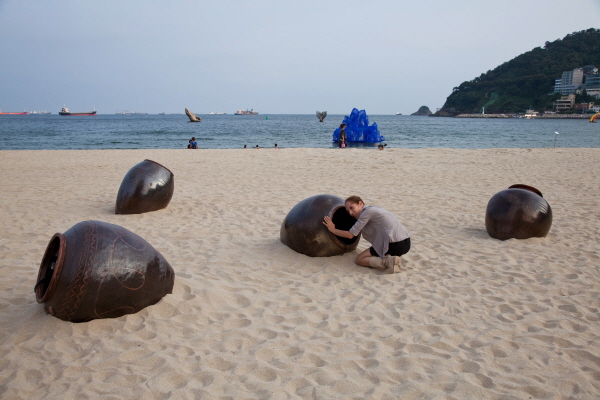
2013 History in an Onggi
Read 5,725
관리자 2013-09-02 20:09


History in an Onggi
1 (H)×0.8(D)m (Each 4ea)
Audio & Video installation
Rachela Abbate and Rebecca Ballestra in the frame of the public art installation History in an Onggi, at Songdo Beach for the Sea Art Festival 2013 with the theme: “With Songdo: Remembrance-Marks-People”
History in an Onggi is a collaborative project of the Italian visual artists Rachela Abbate and Rebecca Ballestra for the Sea Art Festival 2013. The site specific installation is related to the interconnection between local specific experiences, traditions, technology, culture and nature through history. Multimedia installations in combination with traditional craft’s objects reflect those relations. Busan is an example for high technology and environmental standards, guaranteeing sustainability and quality of living. This combination of modernity and sustainability is emphasized, as the artists believe that technology and its sentient implementation is a result of knowledge and collective intelligence expressed in tradition. One of those “time proofed” traditions is the Korean art of pottery, mirroring the merger of manufacturing mastery and philosophy. The related technology embodied in the Onggi is still in use. The Onggi represents various spheres of traditions, history of the collective and of the single life, culture and technology. Therefore the Onggi is used as a space, where expressions take place, pointing to conservation and transformation. As Onggi-making includes the four elements: water, earth, fire and wind, in four Onggi are set video and audio installations related to each element. The media implementations consist in a fusion of interviews, portraits of the inhabitants, their life and work of Busan/Songdo next to the presentation of the natural and urban environment. The history of Songdo is interpreted regarding the relationship of visible and invisible elements which build culture and knowledge.
The artists Rachela Abbate and Rebecca Ballestra are concerning in their researches and artistic operations the connection between social complexities and aesthetical matters in order to initiate a situation of transformation possibilities.
The focus in Rachela Abbate’s artistic production is the idea and function of space in which reflection and transformation can take place. Researches of space as cultural anthropological and mental structure in interaction became fundamental in her theoretical and practical work. Since a few years the artistic transformation into practicing reality has been set in installation works in public space, participatory public art projects and architectural frameworks.
The work of Rebecca Ballestra is focused on the reprocessing and resetting of social, political and environmental themes and on synthesizing ethno-cultural codes, investigated during journeys and several artist residencies program all around the world. Elaborated trans-disciplinary projects, which emphasize communicative and social aspects, set into artistic practise in site and context specific installation, relational projects and photography.
